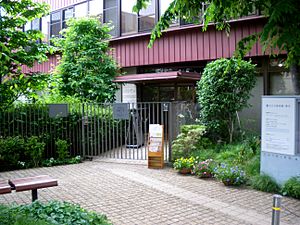Chihiro Iwasaki facts for kids
Chihiro Iwasaki (born December 15, 1918 – died August 8, 1974) was a famous Japanese artist and illustrator. She is best known for her beautiful watercolor paintings. Her art often showed flowers and children. Chihiro's main message through her work was "peace and happiness for children."
Contents
The Early Life of Chihiro Iwasaki
Chihiro Iwasaki was born on December 15, 1918. She was the first daughter of Masakatsu and Fumie Iwasaki. Her birthplace was Takefu, which is now Echizen-city, in Fukui Prefecture, Japan. The next year, her family moved to Tokyo. They lived there until 1945.
As a young girl, Chihiro loved to draw pictures. When she was 14, she started learning drawing and oil painting. Her teacher was Saburōsuke Okada. He was an artist and a professor at the Tokyo School of Fine Arts. In 1936, Iwasaki finished high school. The next year, at 18, she began to learn Japanese calligraphy. This is a special way of writing with ink and a brush.
How Did World War II Affect Chihiro?
In 1939, Chihiro got married. This marriage was arranged by her parents. She moved with her husband to Dalian, in Manchuria. But their marriage ended when her husband passed away. Iwasaki returned to Tokyo in 1941.
In 1945, her family home in Tokyo was destroyed. This happened during an air raid in World War II. Chihiro and her family then moved to her grandmother's home. This was in Matsumoto, Nagano. After the war ended in 1946, she joined a political group. She wanted to help end all wars. She also wished for an end to the suffering of children.
Chihiro's Career as an Illustrator
After moving back to Tokyo, Chihiro became a writer and illustrator. She worked for a newspaper called Jimmin Shinbun. She also drew many pictures for posters, magazines, and school textbooks.
In 1949, a children's book publisher asked her to create a story. It was called Okaasan no Hanashi (The Story of a Mother). This was an educational story told with pictures. It became her first work for children. It was published in 1950 and won an award. This success helped her decide to become a full-time illustrator.
In the same year, she married Zenmei Matsumoto. He was also interested in social causes. In 1951, they had a son named Takeshi. Chihiro often used Takeshi as a model for her drawings of babies and children. These drawings appeared in many children's books and magazines. In 1952, she built a home in Nerima, Tokyo. After she passed away, this home became The Chihiro Art Museum Tokyo.
What Awards Did Chihiro Win?
In 1956, Iwasaki wrote her first picture book. It was called Hitori de Dekiru yo (I Can Do it All by Myself). That year, she won an award for her children's illustrations. In 1960, her book AIUEO no Hon (The Alphabet Book) won another award.
In 1966, Iwasaki moved to a small house with a studio. This was in the Kurohime Highlands, near Lake Nojiri. She loved this area. She spent a lot of time there creating illustrations for children's books every year.
In 1971, her book Kotori no Kuru Hi (The Pretty Bird) won a prize in Italy. Another book, Senka no Naka no Kodomo-tachi (Children in the Flames of War), was published in 1973. It won a bronze medal in Germany the next year.
Chihiro Iwasaki passed away in 1974. She was 55 years old. Seven years after her death, a famous book was published. It was called Totto-Chan: The Little Girl at the Window. It was written by Tetsuko Kuroyanagi. This book included many of Chihiro's beautiful illustrations.
Chihiro's Artistic Style
Most of Chihiro's illustrations were watercolors. But some of her art also used Japanese calligraphy. She also created a few oil paintings. Her style was greatly influenced by two of her favorite writers. They were Kenji Miyazawa and Hans Christian Andersen. She also felt a connection to the artist Marie Laurencin. Chihiro was also impressed by the artist Käthe Kollwitz.
Where Can You See Chihiro's Art?
There are two museums dedicated to Chihiro Iwasaki. They help remember her and her art.
- The Chihiro Art Museum Tokyo is in Nerima, Tokyo. It opened in 1977.
- Chihiro Art Museum Azumino is in Azumino, Nagano. It opened in 1997.
Both museums are run by the Chihiro Iwasaki Memorial Foundation. They collect and show original illustrations. These include Chihiro's works and art by other children's book artists.
Chihiro's Famous Works
Chihiro Iwasaki created nearly 7,000 drawings in her lifetime! Here is a list of some of her well-known works:
- Okasan no Hanashi (The Story of a Mother), 1949
- Hitori de Dekiru yo (I Can Do It All by Myself), 1956
- AIUEO no Hon (The Alphabet Book: A-I-U-E-O), 1960
- E no Nai Ehon (What the Moon Saw), based on a story by H.C. Andersen, 1966
- Tsuru no Ongaeshi (The Crane Maiden), 1966
- Watashi ga Chiisakatta Toki ni (When I Was a Child), 1967
- Ame no Hi no Orusuban (Staying Home Alone on a Rainy Day), 1968
- The Red Shoes, based on a story by H.C. Andersen, 1968
- Kotori no Kuru Hi (The Pretty Bird), 1973
- Senka no Naka no Kodomo-tachi (Children in the Flames of War), 1973
- Akai Rosoku to Ningyo (The Red Candles and the Mermaid), published after her death in 1974
- Hans Christian Andersen, The Little Mermaid, illustrated by Chihiro Iwasaki, 1984
- Anthea Bell Swan Lake: A Traditional Folktale, illustrated by Chihiro Iwasaki, 1986
- Jacob and Wilhelm Grimm, Snow White and the Seven Dwarves, illustrated by Chihiro Iwasaki, 1985
- Totto-Chan: The Little Girl at the Window
See also
 In Spanish: Chihiro Iwasaki para niños
In Spanish: Chihiro Iwasaki para niños



